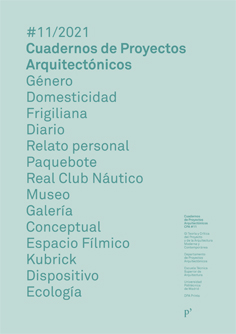Infrastructure Space: Architectural Practice and Operational Logics in the 21st Century
DOI:
https://doi.org/10.20868/cpa.2021.11.4838Palabras clave:
Infrastructure, Infrastructure Space, Apparatus, Medium, EcologyResumen
Abstract
The purpose of this research is to study the intersection between 21st century architecture and infrastructure, understood as a physical fact as well as an abstract concept, through the notion of Infrastructure Space. Since the 1960s, the definition of infrastructure has been changed towards a conceptual version, moving among different disciplines, from Engineering to Humanities. At present, its material condition as an urban system is overwritten with its potentiality, as a transdisciplinary tool, which can explain economic, political, sociological and urban phenomena. Its double material-conceptual condition and its capacity to operate in multiple scales oblige us to expand once again the meaning of infrastructure, opening up to the concept of infrastructure space. This paper hypothesis relies on the fact that infrastructure space is a practical and theoretical device, extracted from infrastructural logics, which is consolidated as a design instrument in contemporary architecture. This new architecture seeks no longer to reproduce the infrastructural model but its logic. This allows us to apply them in the project with independence with respect to the scale and the program involved. To prove this, two concepts of infrastructure and infrastructure space will be postulated, which will be compared to several architectural works in order to show specific project strategies derived from this relation, resulting in infrastructure space.
Descargas
Referencias
Agamben, Giorgio. ¿Qué es un dispositivo? seguido de El amigo y de La Iglesia y el Reinos, trad.Mercedes Ruvituso. Barcelona: Anagrama, 2009.
Allen, Stan. “Infrastructural Urbanism” en Points + Lines : Diagrams and Projects for the City, 172-182. New York: New York Princeton Architectural Press, 1999.
Bélanger, Pierre. Landscape as Infrastructure. A Base Primer. Londres: Routledge, 2017.
Brenner, Neil. New Urban Spaces: Urban Theory and the Scale Question. Oxford: Oxford University Press, 2019.
Delalex, Gilles; Moreau, Yves. “On Complexity, Studio Muoto. Urban Condenser, Paris-Saclay (France) 2016”. a+t ‘Complex Buildings’ no. 48 (2017): 26-35.
Easterling, Keller. Extrastatecraft: The Power of Infrastructure Space. Londres: Verso, 2016.
Fernández Galiano, Luis (ed.). “MVRDV Holanda”, Arquitectura Viva ‘Hannover 2000’ no.72 (Mayo 2000): 48-53. https:// arquitecturaviva.com/obras/ pabellon-de-los-paisesbajos- en-la-expo-2000
Fernández Galiano, Luis (ed.). “MVRDV Dream Works”, AV Monografías no. 189-190 (2016).
Harvey, Penelope; Casper, Jense; Morita, Atsuro (eds.). Infrastructures and Social Complexity: A Companion. Londres: Routledge, 2017.
Ingels, Bjarke. “Placeres pragmáticos” en AV Monografías ‘BIG 2001- 2013’ no. 162 (2013): 4-11 https://arquitecturaviva. com/articulos/placerespragmaticos
Koolhaas, Rem. Small, Medium, Large, Extra- Large : Office for Metropolitan Architecture : Rem Koolhaas and Bruce Mau. (Ed.) por Bruce Mau y Jennifer Sigler. New York: Monacelli Press, 1997.
Lacaton, Anne; Vassal, Jean-Philippe. “Materia al desnudo. La escuela de Arquitectura de Nantes explicada por sus autores”, Arquitectura Viva no. 124 ‘Banda ancha. Obras digitales: de la estructura a la piel’ (2009): 84-85.
Lecavalier, Jesse. “Let’s Infrastructure!” en:Infrastructure as Architecture: Designing Composite Networks, Katrina Stoll and Scott Lloyd (eds.). Berlin: Jovis, 2009.
Martin, Reinhold. The Urban Apparatus: Mediapolitics and the City. Minneapolis; London: University of Minnesota Press, 2016.
McHarg, Ian. Design with Nature. Nueva York: Natural History Press, 1969.
McLuhan, Marshall. Understandings Media: The Extensions of Man. New York: McGraw-Hill y Londres: Routledge & Kegan Paul, 1964, 2001.
Rojas, Javier Agustín. “Sobre la neutralidad”, PLOT no. 35 (Marzo 2017).
Ruby, Ilka & Andreas (eds.).Infrastructure Space. Berlin: Ruby Press, 2017.
Waldheim, Charles. Landscape as Urbanism: A General Theory. Princeton: Princeton University Press, 2016.
Williams, Rosalind. “Infrastructure as Lived Experience”, Conferencia impartida en el ciclo Conference.Massachuset
Descargas
Publicado
Número
Sección
Licencia
1. Los autores conservan los derechos de autor y garantizan a la revista el derecho de una Licencia Creative Commons Atribución-NoComercial-SinDerivar 4.0 Internacional que permite a otros compartir el trabajo con un reconocimiento de la autoría.
2. Los autores pueden establecer por separado acuerdos adicionales para la distribución no exclusiva de la versión de la obra publicada en la revista (por ejemplo, situarlo en un repositorio institucional o publicarlo en un libro).












